Bhutan: Land of the Thunder Dragon
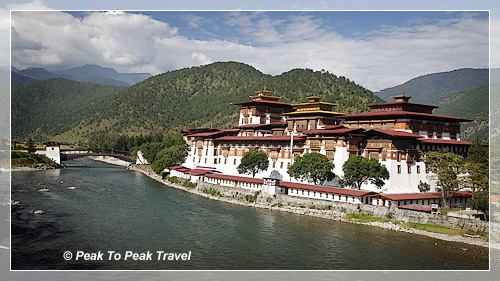
The famous Punakha Dzong monastery in Bhutan
Trip Highlights
- Hike to temples, villages, and passes for stunning views and cultural insight
- See the majestic, natural beauty of Bhutan's mountains, lakes, and forests
- Witness a famous Bhutan "Teschu", festival, with mask dances
- Travel with exceptional Bhutanese guides
This mystical Himalayan kingdom only opened its doors to tourism in the 1980’s and continuously strives to maintain its cultural identity by resisting western influences. The Bhutanese have a unique view of life and way of doing things that can be quite perplexing, but having travelled across Bhutan ourselves we’re able to offer first-hand advice and plan your Bhutan tour to give you an incredible holiday in this truly amazing country. In Bhutan even the ordinary is extraordinary; there are no traffic lights, even in the capital Thimphu, and the last king introduced the now famous "happiness principle" which rejected GDP as a measure of progress and chose instead to value the country's progress in terms of Gross National Happiness.
Our journey gives us an insight into Bhutanese life by visiting the towns with their splendid dzongs (monasteries/forts) and trekking along a classic Himalayan route. The five day trek follows the ancient high level route between Paro and Thimpu. We trek through splendid rhododendron forests, crossing several passes including the Phume La. En route we pass yak herders settlements and camp beside clear blue mountain lakes with splendid views of the peaks which border Tibet including Gangar Punsum and Jichudrake. In Paro we visit Takstang Monastery and in Thimpu we visit the impressive Tashichodzong. The spring and early fall departures visit the Paro and Thimpu festivals respectively whilst the October departure coincides with the best time for trekking. Please contact us for the detail itineraries for these festival.
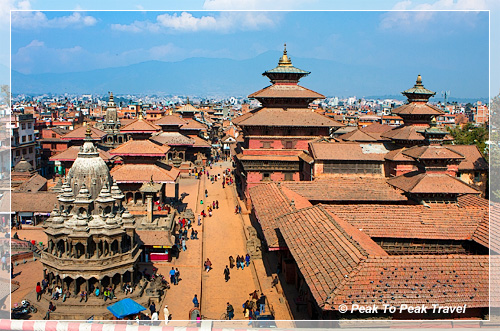
The Kathmandu Durbar Square, Kathmandu, Nepal
Day 1 Arrival in Kathmandu
We arrive in Kathmandu
and transfer to the Yak and Yeti Hotel (www.yakandyeti.com), one of the finest hotel in Katmandu with excellent accommodations and a quiet atmosphere to unwind. A good rest is highly recommended to offset jet lag!
Day 2 Paro
We fly to Paro today. If the weather is clear, we should get a fantastic view of much of the eastern half of the Himalaya, including Everest, Kanchenjunga and Chomolhari (Jhomolhari). After completing visa formalities in Paro, we transfer to our hotel. The Paro valley is considered to be one of the most beautiful in Bhutan. Its blue pine-covered hills and attractive, solidly built farmhouses among the paddy fields are dominated by the massive Dzong, or fort. This afternoon we aim to visit the Paro Dzong and the National Museum above it. Paro Dzong is one of Bhutan's most impressive, and the finest example of Bhutanese architecture you will see. The inward sloping walls form a massive structure that towers over the town. Built in the 17th century it was one of Bhutan's strongest and most important fortresses and it was used on several occasions to defend the Paro Valley from invasions by Tibet. Formally the meeting hall for the National Assembly, the Dzong now houses a monastic school and district government offices. Scenes from the 1995 film 'Little Buddha' were filmed in the Dzong. West of the Dzong a traditional wooden covered bridge called Nyamal Zam, a reconstruction of the original bridge, which was washed away in a flood in 1969. The most famous pictures of Paro Dzong are taken from the west bank of the river, just downstream from the bridge. At the top of the hill above the dzong is the old watchtower known locally as Ta Dzong. Originally built in 1656, it was renovated in 1968 by King Jigme Dorje Wangchuk to house the National Museum. This round building is said to be in the shape of a conch shell and there is a specific route to follow throughout the entire building, which ensures that you walk clockwise around important images. Inside the museum there is a spectacular collection of thangkas, an extensive philatelic collection, a temple, which depicts the history of Buddhism, ancient bronze and stone objects and displays of weapons captured during the Tibetan invasions. (Please note that if there are flight delays we have time tomorrow to visit the Dzong and museum).
Day 3 Paro Festival
We spend all of today at the spectacular Paro festival. This is the most famous festival in Bhutan and thousands of people gather to see the monks dressed in colourful brocade, silk costumes and wearing painted masks re-enact the story of the gompa's particular divinity though music and dance. For several days there are masked dances, prayer meetings and a general carnival atmosphere prevails as many villagers arrive to meet old friends.
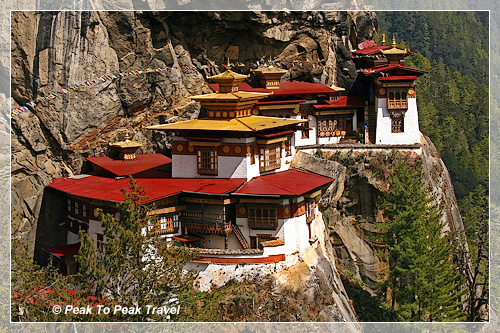
The Sacred Tatkshang Lhakang Bhutan
Day 4 Takstang Monastery
Today we will have a warm up hike to Takstang Monastery. Takstang, or 'Tigers Nest' Monastery, is perched on the ledge of a cliff high above the Paro Valley. Partly destroyed by fire in 1998, it has now been completely restored to its former magnificence. We drive a short distance from the hotel and then we hike to a viewpoint where there is a small cafe for the classic views of the monastic buildings which cling almost impossibly to the cliff wall opposite. For the energetic there is the chance to walk even higher to the actual monastery. Returning to the hotel we have time in the afternoon to explore Paro town.
Day 5 Ta Dzong
Today we start our trek. After breakfast we have a short drive to the road head at the ancient Ta Dzong watchtower (2510m). The first day's trekking is quite hard as we gain quite a lot of height and it's all the way uphill. From Ta Dzong it is a gentle one hour climb to a fork in the trail. The trail then climbs steeply up to our camp just below Jele Dzong (3450m). If the weather is clear we can see the whole of the Paro Valley below and in the distance is Chomolhari. Approximately 9km, 4 to 5 hours walking
Day 6 Jele Dzong
After breakfast we have time to explore the Jele Dzong and we may be lucky to be allowed inside. Our days walk begins with a climb through thick rhododendron forest to the Jele La (3490m) and onto a saddle at 3590m. We may even see great views of Chomolhari. Look out for the colorful Monal Pheasants which inhabit the forests. The trail climbs the ridge most of the day through forests of rhododendrons. We camp tonight at the yak herder's settlement called Jangchu Lakha (3780m). Approx 11km, 5 to 6 hours walking.
Day 7 Jichudrake
The trail today follows the ridge and on clear day we have Spectacular Mountain views particularly of the magnificent Jichudrake. Look out today for Blood pheasants and Blue Sheep. We camp close to the lake of Jimi Lang Tscho (3880m), well known for its giant trout. Approx 12km, 4-5 hours walking
Day 8 Labana
A long but great day's walk with good mountain views. The trail undulates all day through the dwarf rhododendron forest and past Janye Tscho Lake. Passing Simtoka Lake we come to our camp at Labana (4130m). Far below us is the Thimpu Valley. Approx 13km, 5-6 hours walking
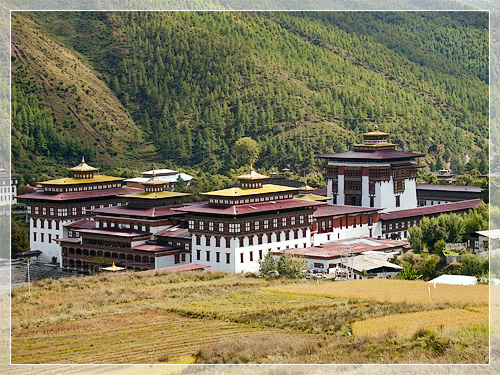
Tashichhoe Dzong
Day 9 Motithang
The trail today climbs gradually up to the Labana Pass at 4235m (the highest point of this trek) from where we traverse the hillside with great mountain views. On a clear day we should see Gangar Punsum, the highest mountain in Bhutan and Kanchenjunga. A long descent through forests of blue pine brings past Phajoding monastery to the end of our trek at Motithang, just above Thimpu, the capital of Bhutan. We should reach our hotel by midafternoon. The evening is free to explore Thimpu. Approx. 10km, 4 - 5 hours walking.
Day 10 Tashichhoe Dzong
We spend most of today visiting the main sights of the town including the Tashichho Dzong, which is the centre of the Bhutanese Government, the Memorial Chorten, which was built in 1974 to honour the memory of the third king, Jigme Dorji Wangchuk, Simtokha dzong and a painting school. In the late afternoon we have a short (1hour) drive back to Paro.
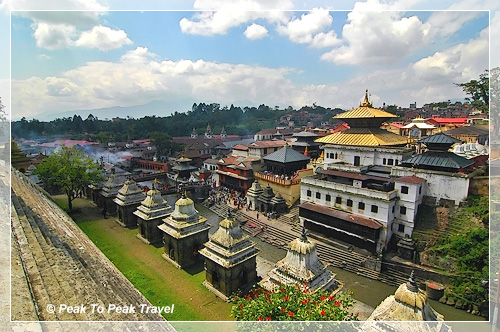
The Pashupatinath Temple, Kathmandu, Nepal
Day 11 Kathmandu
Today we fly back to Kathmandu. The rest of the day is free to explore the temples and markets of Kathmandu or go shopping. We have several sightseeing tours on offer (see the notice board in the hotel in Kathmandu), or you may want to explore Kathmandu on your own. The Kathmandu Durbar Square is full of ancient temples and palaces. You may want to visit the monkey temple at Swayambhunath or the largest Hindu temple in Nepal at Pashupatinath or the one of the largest Buddhist stupas in Asia at Bodnath. Once you have had your fill of culture the colorful markets of Thamel are great for souvenir shopping.
Day 12 Mountain Flight in Nepal
You will have the opportunity to take an optional mountain flight over the Mt. Everest region today!
| Land Cost: $4299 | Single Supplement: $450 |
Travelers are responsible for round trip airfare from the USA to Nepal. Singapore Airlines has recently reduced their round trip airfare between Denver and Katmandu with a connection in either Los Angeles or San Francisco to just ~ $1600, making this long journey an affordable option. Travelers are also responsible for purchasing their own mandatory evacuation and travel insurance. Other personal costs include bottled drinks and alcoholic beverages, meals and transportation on free days in Katmandu, personal shopping, tips for staff, visa fees, and airport exit fees (if applicable). Thank you and we look forward to making your Adventure in Nepal, and Bhutan an unforgettable one!







